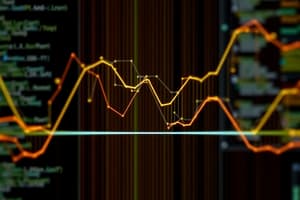Podcast
Questions and Answers
Which programming language is inspired by the S programming language?
Which programming language is inspired by the S programming language?
- Python
- C++
- R (correct)
- Java
What does CRISP-DM stand for?
What does CRISP-DM stand for?
- Cross-Industry Standard Process for Data Mining (correct)
- Complex Regional Information Sharing Protocol for Data Management
- Cross-Regional Information Standard Process for Data Management
- Common Research Information System for Data Mining
What is a dataset organized in?
What is a dataset organized in?
data matrix
What are variables in a dataset?
What are variables in a dataset?
The difference between the maximum and minimum values is called the ______.
The difference between the maximum and minimum values is called the ______.
What is the measure of central tendency that represents the middle value called?
What is the measure of central tendency that represents the middle value called?
What term describes the 'average distance' of observations from the mean?
What term describes the 'average distance' of observations from the mean?
Unstructured data can be stored in a table.
Unstructured data can be stored in a table.
What does the interquartile range (IQR) measure?
What does the interquartile range (IQR) measure?
The most frequently recurring value in a dataset is known as the ______.
The most frequently recurring value in a dataset is known as the ______.
What is an outlier?
What is an outlier?
What is the primary purpose of data visualization?
What is the primary purpose of data visualization?
What can make a graph misleading?
What can make a graph misleading?
Correlation measures the strength of nonlinear relationships between variables.
Correlation measures the strength of nonlinear relationships between variables.
Flashcards are hidden until you start studying
Study Notes
R and RStudio
- R is an open-source programming language widely used in data science.
- Its availability of libraries allows for quick integration of new concepts.
- R release names are often linked to characters from the Peanuts cartoon.
- RStudio is an Integrated Development Environment (IDE) for R, providing a command-line interface.
Notebooks
- Notebooks are documents combining code, output, and formatted text.
- They are essential for reproducible data analysis.
R
- R is inspired by the programming language S, serving as its modern version.
Data Science Process
- CRISP-DM: (Cross-Industry Standard Process for Data Mining) provides a framework for data science projects.
- Wickham & Grolemund: Defined a model outlining the tools needed in typical data science projects.
- PPDAC: (Problem, Plan, Data, Analysis, Conclusions) A structured approach for data analysis.
- O’Neil & Schutt: Their work also contributes to understanding data science methodologies.
Dataset Organization
- Datasets are structured as data matrices.
- Rows represent observations, and columns represent variables.
- Observation: A single unit of measurement (e.g., an animal, a plant, a person)
- Variable: A specific feature or attribute of an observation.
Data Types
- Datasets can be structured or unstructured.
- Structured data can be organized in a table, with consistent structure for all observations.
- Unstructured data lacks a consistent structure (e.g., webpages, emails, images).
- Data can be extracted from unstructured sources to create structured data.
- Different data types (e.g., logical, numeric, character, factor) influence the applicable analysis methods.
Summary of Datasets
- Measures of central tendency: Mean, median, and mode describe the "typical" value for a variable.
- Range: The difference between the maximum and minimum values.
- Median: The middle value in a sorted dataset.
- Mean: The average of all values.
- Mode: The most frequently occurring value.
Dispersion
- Dispersion: How spread out the values are.
- Range: Difference between the maximum and minimum.
- Interquartile Range (IQR): The difference between the third and first quartiles.
- Variance: The average of squared deviations from the mean.
- Standard Deviation: The square root of variance, representing the "average distance" from the mean.
Outliers
- Outliers: Extreme values significantly different from other observations.
- Values more than 3 standard deviations from the mean are often considered outliers.
- Outliers can heavily influence the mean, making the median a more robust measure of central tendency.
Relationships Between Variables
- Correlation: Measures the strength of the linear relationship between two variables.
- Correlation coefficient ranges from -1 to 1:
- 1: perfect positive correlation
- 0: no correlation
- -1: perfect negative correlation
Data Visualization
- Data visualization uses plots, charts, and graphs to summarize data, identify errors, and communicate findings.
- Histograms are useful for visualizing the distribution of data.
- The choice of the number of bins in a histogram significantly impacts its appearance.
Importance of Visualization
- Exploratory data analysis: Provides a visual understanding of the data.
- Error detection: Helps identify outliers, cleaning issues, and erroneous assumptions.
- Communication: Effectively conveys data and findings.
Misleading Graphs
- Using misleading techniques can distort data visualization:
- Leaving gaps in the scale
- Changing scales inappropriately (especially on the vertical axis)
- Emphasizing certain sections unfairly
- Distorting areas
- Employing 3D charts
- Using pictograms incorrectly
- Making unjust extrapolations
Models
- Models represent aspects of reality based on underlying assumptions.
- It's crucial to consider and test the validity of these assumptions.
Patterns, Variation, and Covariation
- Patterns in data reveal potential relationships between variables.
- Variation introduces uncertainty.
- Covariation: When two variables vary together, the value of one can improve predictions about the other.
Signal and Noise
- Observed data consists of two components:
- Signal: Predictable mathematical form.
- Noise: Random, unexplained contributions.
- Finding patterns in data involves identifying the signal. This process is akin to learning from the data.
Studying That Suits You
Use AI to generate personalized quizzes and flashcards to suit your learning preferences.




